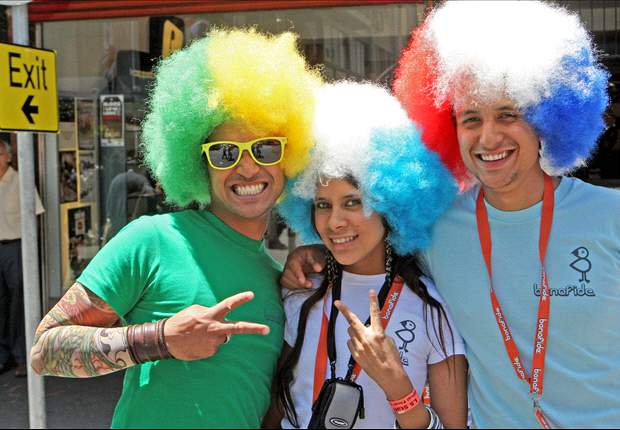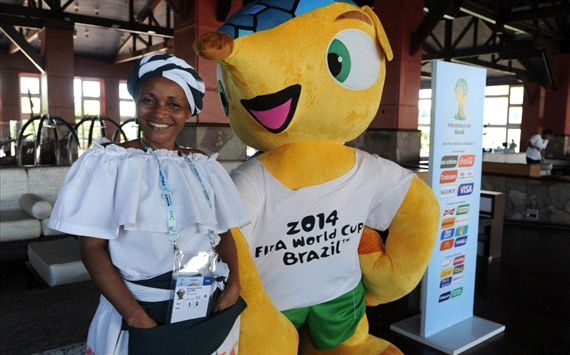
Fancy nicknames borne by the countries qualified
for next year's World Cup are sure to add to the fun and excitement
anticipated at the tournament. Goal compiles and explains some
FEATUREBy Sammie Frimpong
As the finest footballing nations on earth gather in Brazil next summer to pit their strengths against each other in pursuit of international soccer's ultimate prize, nicknames would be used by commentators and fans almost as frequently as the participating teams' actual names.
 Fact is, behind each of these monikers is a story, ranging from the remarkably simple to the very complex. Goal
sheds some light on most nicknames that might be heard at the World
Cup, and why they aptly describe the sides that respond to them.
Fact is, behind each of these monikers is a story, ranging from the remarkably simple to the very complex. Goal
sheds some light on most nicknames that might be heard at the World
Cup, and why they aptly describe the sides that respond to them.Hosts Brazil possess almost as many nicknames as they do world titles. The flamboyant Brazilians are known, among others, as the Pentacampeoes (highlighting their being five-time world champions), the Verde-Amarela/Auriverdes or the Canarinhos (the Green-and-Yellow/Greens-and-Gold or the Canaries, in recognition of the team's strips), A Selecao (Portuguese for 'The Selection'), and the Samba Kings, acknowledging a popular dance in the South American country and the national team's patented brand of easy-on-the-eye football.
Interestingly, a significant fraction of the countries to be represented at the World Cup have picked their own nicknames for reasons quite identical to Brazil's. For one, the rather simple-sounding 'The Selection' translates into La Seleccione and La Sele for Spain and Costa Rica respectively. Portugal, former colonial lords of Brazil, are also A Seleccao but do qualify their version of the name with the phrase 'das Quinas' ('of the Shields'), signifying the five escutcheons found on the country's flag and coat of arms.
Again, like Brazil, others have based their nicknames on what colours are prominent in their regular kits which, as a general rule, reflect heavily in the country's flag. Take neighbouring Argentina and Uruguay as examples. The former's blue and white stripes, evident in its jerseys and flag, gives the team its 'Albiceleste' (to wit, 'White and Sky-Blue' in Spanish) name, while Uruguay, for very much the same reasons, call themselves the 'Celeste': Sky-Blue. Actually, the colour was first worn by the national side some 103 years ago, as a tribute to FC River Plate, a Uruguayan club outfit once thriving but now defunct. Staying with the tradition of blue hues, Greece are the Galanolefki - the 'Sky-Blue and White' - and France, in their deep blue shirts, are Les Bleus (The Blues).
Ecuador, also a continental sibling of Brazil's, call themselves the Amarillos by virtue of their own yellow uniforms. Following the same criteria, green-kitted Mexico, from north America, are referred to as La Verde (The Green One). On occasions when the fans are a little less pleased with their displays, as in the manner that saw them labour towards a playoff berth against New Zealand, the Mexican team is referred to as Los Ratones Verdes, the Green Mice.
Colours and peculiar features of flags also serve other countries very well. The American banner, easily one of the world's most recognizable symbols, is designed with several Stars and Stripes, from which Team USA derive their most frequently used nickname. In a similar vein, Ghana's flag, with a bold, black five-pointed star emblazoned in the yellow horizontal space that separates the red (top) and green (bottom) sections, is the reason why the country's national team is famously known as the Black Stars. The star itself was adopted as a national symbol by Ghana's first post-independence leader Kwame Nkrumah, in memory of Pan-Africanist Marcus Garvey's shipping line, the Black Star Line. South Korea, the Taeguk Warriors, have the first part of their moniker paying homage to the 'taeguk', the yin-yang symbol found in the middle of the otherwise mostly white space that is the country's flag.
For countries like Mexico, Ecuador, and Honduras, the fascination with flags differs slightly, whereby the number of prominent colours in there induce the nickname. With three each, Mexico and Ecuador are known as El Tricolore/El Tri, while Honduras, with one less, are La Bicolor. Honduras are also hailed, rather cutely, as La H; 'H' being the first letter in the country's name.
With respect to flags corresponding to a country's preferred jersey and its nickname, there are a few exceptions, notably Italy, the Netherlands, and Japan. In each case, the back-story is steeped in history.
In the case of Italy, the most successful nation at Fifa World Cup level after Brazil, the name Azzuri and the jet-blue shirts it has inspired over the years can be traced to the 19th century when Victor Emmanuel II, who sought to unify a fragmented peninsula, became Italy's first king in 1861. The new ruler was a member of the House of Savoy, the official colours of which was blue, hence its adoption for national use by a country whose flag features only red, white, and green. Similarly, the Dutch national team, runners-up at the last World Cup, parade, not in the red, white and blue that make up their national flag, but in bright orange - thus the name Oranje - because the country's royal family belongs to the House of Orange-Nassau whose livery is...yes, orange!
England's Three Lions nickname also has regal origins, with the design of the three lions passant guardant adorning the English FA crest the national team proudly bears each matchday being based on the Royal Arms of England.
The colours of the Japanese national football team have alternated over the years, mainly between red-and-white (which would only be natural due to the obvious ties with the country's flag) and blue-and-white. Needless to say, it is the latter that has survived, but only largely due to an age-old superstition - or so it is believed. In its first major appearance at an international competition, the 1936 Summer Olympics, Japan used a blue kit against Sweden and won 3-2. Since then, there has hardly been any doubt over what ought to be the country's primary footballing colours, and thus the 'Blue' is deservedly credited in the team's nickname. The other half, 'Samurai', is a testament to the brave, fear-inspiring warriors of feudal Japan whose all-conquering spirit perhaps the modern nation hopes to invoke on the football pitch whenever they turn out to do 'battle'.
Others have seemingly made a fetish out of the colour red, among them Spain (La Furia Roja -the Red Fury), South Korea (the Reds), and Chile (La Roja - the Red One). Red, among other things, denotes heat and fiery intensity and, in this regard, Croatia, the Vatreni (Blazers), find themselves in good company, ready to devour any prospective opponents with the sort of fire with which they razed Iceland down in the playoffs via which they qualified for next year's Mundial.
Belgium do belong to the category of 'reds', being touted as the Red Devils, yet for entirely different reasons, they'd rather be paired with Switzerland. Both countries, being strategically placed in European and global affairs, are multicultural melting pots, and that very fact is seen in their respective epithets which are rendered in a number of languages. Belgium's national side are also called the Rote Teufel (German), Rode Duivels (Dutch), and Diables Rouges (French), while Switzerland's goes by Schweizer Nati, La Nati, or Squadra Nazionale, depending on whether they are being referred to by German-, French- or Italian-speaking Swiss respectively.
Many nicknames also reflect national symbols or identities indigenous to a particular people. Colombia, for instance, are Los Cafeteros (The Coffee-growers), a name chosen in celebration of the country's world-famous coffee-growing reputation, while the Portuguese's and the Greeks' adventurous sea-faring history earns them the titles Os Navegadores (The Navigators) and Piratiko (Pirates) respectively.
World Cup debutants Bosnia and Herzegovina are known as the Zlatni Ljiljani (the Golden Lilies), a species of lily that is native to the country. When Bosnians wish to describe their team in terms that might sound somewhat more threatening and which certainly belies their status as underdogs, they call them the Zmajevi (the Dragons) yet, of course, even that would put few opponents off. Australia, home of the lovable marsupials, have married the name of arguably the most popular of them all - the kangaroo - with the word 'soccer' to coin the national side's creative alias, the 'Socceroos'.
Speaking of dragons and kangaroos, the African teams also bring something unique to the table. Africa, a world with its past thoroughly washed in animism, attributes great reverence to wildlife. Consequently, four of the five sides representing the continent are named after beasts of the field (and of the skies) famed for their strength, might, and predatory instincts. Cameroon are the Indomitable Lions, the lion being the proverbial king of the jungle in many an African folktale; Cote d'Ivoire, Les Elephants, have always been a hub for the gigantic, lumbering animal whose ivory tusks give the west African nation half of its official name; Algeria, the Desert Foxes/Les Fennecs, are proud to associate themselves with the wily, large-eared nocturnal creature that is their national animal; while Nigeria, formerly known as the Red Devils, adopted the Green Eagles (green being the colour of the team's first-choice kits and more dominant in the country's flag) nickname after attaining independence, before adding the 'Super' sobriquet when they won the 1994 Nations Cup.
Other sides have opted for more modest and less imaginative names. Iran, Russia and Germany are Team Melli, Sbornaya and Die Nationalmannschaft respectively, all three terms simply meaning 'National Team'. 'Ethniki', yet another of Greece's nicknames, loosely translates as 'National'.
Come June 2014, however, all 32 teams would know better than draw strength from just their nicknames, however intimidating or innocuous they might sound. ---------------- goal.com
No comments:
Post a Comment